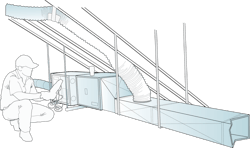Halloween, the holiday that nightmares are made of, is over. Many contractors relive frightening experiences daily because of nightmare jobs they can’t seem to escape. It seems they sold an extended warranty on a system that keeps haunting them.
With extra attention to detail during your installations and maintenance visits, you can limit how much you pay out on an extended warranty.
Extended service warranties are common in our industry. Many HVAC companies offer them, and they often cover the customer’s cost of repairs as much as 12 years beyond the installation date.
With extra attention to detail during your installations and maintenance visits, you can limit how much you pay out on an extended warranty. Otherwise, you may ultimately lose any profit in the job and create unhappy customers who haunt your company. Let’s look at five installation details you should confirm to reduce your future warranty nightmares.
One: Select the Proper Equipment
The first detail might sound obvious, but it’s easy to overlook. Make sure any equipment you install is matched and sized to work together. It’s amazing how many issues this can prevent upfront.
I never understood why some contractors would install a new heat pump on a 15-year-old air handler. They offer a warranty on the heat pump but remain silent about the existing air handler and other system components. Low price got them in the door, but they often ended up owning a Frankenstein monster.
For a system to perform near its rated capacity in the field, you must install equipment components to reflect best how the manufacturers intend them to operate. When components are mismatched, equipment d cannot perform as designed, reducing system performance. This results in increased failures and complaints, which increases your liability.
Two: Purge and Evacuate
Another field variable to consider is the impact of refrigerant lines connecting the outdoor and indoor sections of split system equipment. If they are not sized and installed according to manufacturer specifications, further problems will occur.
You can avoid many issues by purging refrigerant lines with nitrogen while soldering or brazing to prevent scale formation. Scale that coats the inside of the copper lines can be washed off by polyolester (POE) oil. This results in a restricted metering device, reduced heat transfer, poor system performance, and may murder aProper evacuation is also important to system longevity since it removes moisture and non-condensables from the refrigerant lines. Use a micron gauge to verify you pulled an adequate vacuum and that it will hold once isolated with ball valves. Don’t rely on your manifold’s suction gauge to determine the proper vacuum. Better yet, don’t use your charging manifold to pull a vacuum. Instead, purchase a vacuum assembly intended for the job.
Three: Set Fan Airflow
Low airflow seems to cause more warranty issues than any other problem. For equipment to have any chance at a long and useful life, fan airflow must be correct. If the airflow is low, everything else is wrong, and the equipment will slowly suffocate.
A fan should typically move between 350 to 400 cfm (cubic feet per minute) per ton in cooling mode. If you’re testing a three-ton system, the fan should move approximately 1050 cfm (350 x 3 = 1050) to 1200 cfm (400 x 3 = 1200) across the indoor coil.
Undersized and restrictive duct systems are a primary cause of low airflow.
Undersized and restrictive duct systems are a primary cause of low airflow. Restrictive indoor coils and air filters contribute to this issue, even when clean. It’s important to understand that these problems make it impossible to get accurate refrigerant charges or temperature readings. So, check fan airflow before you hook up your refrigerant gauges and adjust the charge.
Four: Verify Refrigerant Charge
Refrigerant charge is the fourth installation detail you should confirm. Don’t just open the service valves and/or weigh in the charge and assume all is good.
Check superheat to ensure the compressor isn’t flooded or starved for refrigerant. Also, check subcooling to ensure the condenser has the proper amount of liquid refrigerant flowing to the metering device.
Beyond the refrigerant charge, you need proper start-up procedures to ensure the equipment performs as designed.
Beyond the refrigerant charge, you need proper start-up procedures to ensure the equipment performs as designed. Take the time to measure static pressure, airflow, equipment temperatures, voltage, and amp draw. If a defect exists, these measurements usually reveal them. Don’t just power up the equipment, turn it on, and walk away.
Five: Test Combustion Safety
The final detail is also the most important if you install fuel-fired equipment. Don’t be crazy enough to start a fire in someone’s home and assume it’s safe. The only way to know if a furnace is safe is to combustion test it.
Check the flue gases with a combustion analyzer to ensure the carbon monoxide (CO), oxygen (O2), and flue temperatures fall within acceptable ranges and remain stable during equipment operation. If your readings fall outside acceptable limits, it’s a sign you must investigate further.
Don’t forget to measure ambient CO for your personal safety. Not only does this protect you, but it also helps assure that CO from another source isn’t making its way into the conditioned space.
Maintain the Investment
It’s not enough to install equipment correctly. Regular maintenance is necessary to ensure it continues to provide the same performance level as when installed new. Everyone benefits when you keep components clean so they perform well and continue to transfer heat properly.
No matter how well you install the equipment, it has moving parts and electronics that can and will fail. Any extended warranty must require regular maintenance to reduce your risk of paying for avoidable labor and repairs.
Make sure you regularly test the most common items that lead to equipment failure and then document those readings in the service history. Run capacitors, air filters, coils, and blower wheels all require cleaning and regular attention. However, if you find the blower wheel and indoor coil need cleaning each year, that’s a sign of a bigger airside problem.
A great maintenance plan keeps your customers happy and thankful that their investment is in tip-top shape. Instead of being haunted by disgruntled customers, you can maintain a long-lasting relationship with them that’s a joy for years to come.
David Richardson serves the HVAC industry as Director of Training for National Comfort Institute, Inc. (NCI). NCI specializes in training that focuses on improving, measuring, and verifying HVAC and Building Performance.
If you’re an HVAC contractor or technician interested in learning more about reducing your warranty claims, contact David at ncilink.com/ContactMe or call 800-633-7058. NCI’s website www.nationalcomfortinstitute.com is full of free technical articles and downloads to help you improve your professionalism and strengthen your company.
About the Author
David Richardson
Director, technical curriculum
David Richardson serves the HVAC industry as director of technical curriculum at National Comfort Institute, Inc. (NCI), Avon, Ohio. NCI specializes in training that focuses on improving, measuring, and verifying HVAC and Building Performance.

